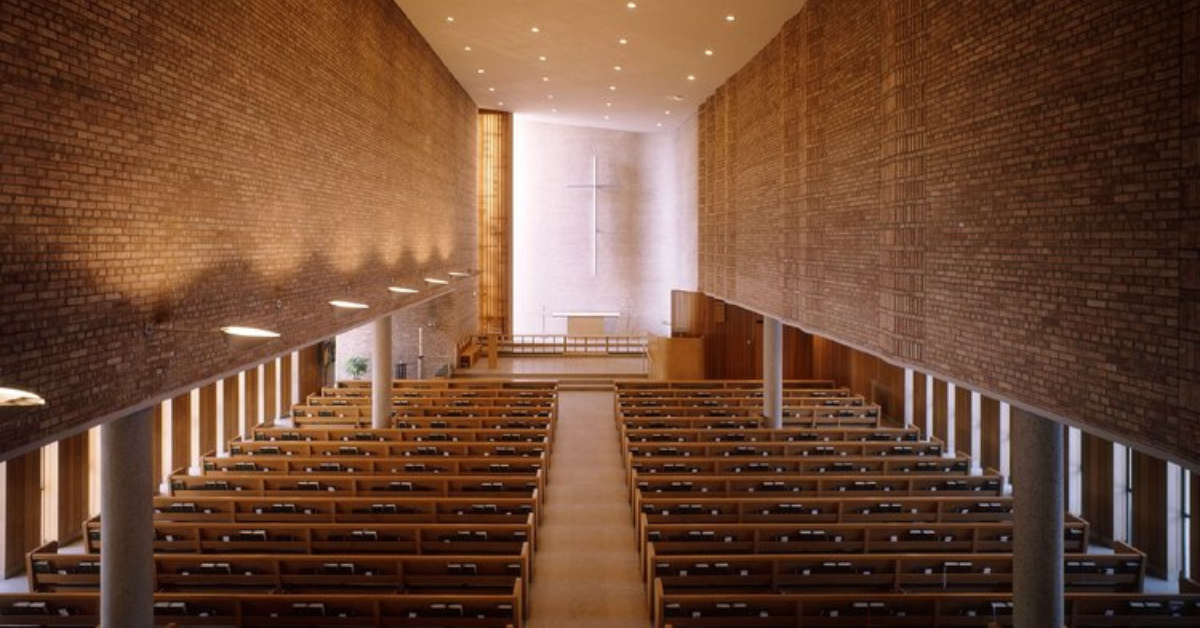I will never forget the first time I walked into Christ Church Lutheran in Minneapolis, MN. I had just started my seminary career at Luther Seminary and I was in the market for a new church home after graduating from St. Olaf College in Northfield, MN and moving to the Twin Cities. Both the sanctuary and the education building are stunning works of art – designed by the famed architects Eliel and Eero Saarinen. It’s clear why the beautiful building was named a national historic landmark.
Aesthetics aside, it was also clear to me that these spaces were built with a different era of ministry in mind. The sanctuary was built in 1949 and the education wing was completed in 1962 – a time when the congregation likely needed every one of its 450 seats in the sanctuary. Long-time members often regaled me with stories of putting folding chairs in the aisles to accommodate everyone for Easter and Christmas. The space was bursting with members!
However, as I entered the space in 2010, the sanctuary was only a quarter full. Despite having about one hundred people in attendance, the space felt empty. As much as the congregation loved their building, it was clear this space was no longer a perfect fit for the congregation currently inhabiting it.
As someone who didn’t see ELCA churches in their heyday in the mid-20th century, I find that the mismatch between church spaces and the congregations currently inhabiting them is often more noticeable to me than it is to my older member peers. For them, the memories of what the congregation used to look like intermingle with what it looks like today. Many wish to keep the space the same in the hopes that the heyday will return. While I echo their hope for revitalization and increased church attendance, the trendlines tell a different story.
What do you do when the church building no longer fits the church that inhabits it? What do you do when your beloved space becomes more of a burden than a blessing?
I have noticed three different options for moving forward:
- Property Rental: For the 101 congregations who took part in our Funding Forward Research Project, property rental was the most common option. Over 70% of the churches in the research project had used or were considering using this option. Property rental can be a great way to engage your community while also generating regular income. It also has the lowest barrier to entry.
- Property Sale: While less common, this option can have an enormous impact not only on the congregation’s bottom line but also on the congregation’s mission and community impact. It can take a variety of forms from selling the entire property to selling just a piece of it.
- Property Sharing: Even less common than property sale, this option involves more than one ministry sharing ownership in a space. A great example of this is Springhouse Ministry Center in Minneapolis, MN which houses three congregations in an intentional partnership. They share space and staff as well as the costs and income generated from the space.
On Tuesday, May 21 from 12-1:30pm (Central) I will be hosting a workshop: Burden or Blessing? How to Use Your Church Property for Mission where we will talk about these three options, explore creative ways to use your church property, highlight pitfalls to avoid, and answer common questions that arise as congregations explore these options. However, I’m most looking forward to the panel of three leaders who have deepened their ministry’s mission, engaged their community, and created a more sustainable pathway forward by repurposing their property:
- The Rev. Chrisy Ennen: When she came to First Presbyterian Church of Gulf Shores in 2021, they only had enough money to pay her salary for two years. They were a church on the brink and they had to try something new. They decided to fulfill a need in their community by converting part of their church building into affordable, rentable office space. They now have renters in 9 spaces. Read more here.
- The Rev. Barry Randolph: When he started his ministry at Church of the Messiah the congregation had dwindled to just 40 members. While the church had started an affordable housing ministry decades before, Pastor Barry knew there was more the congregation could do to engage its surrounding community and the building was an invaluable resource in the process. The church is now a small business incubator and home to a bike shop, medical clinic, marching band, urban garden, and so much more! Read more here.
- The Rev. Cara Tanis: After Bethany Lutheran Church closed its doors in 2016 and released their property back to the Northwest Washington Synod, the synod decided to invest in the community rather than selling the property. Today, 7400 Woodlawn is a center for community, arts, and spirituality – helping to dispel loneliness in the Green Lake neighborhood of Seattle. They currently have 23 partners who use the space – including two worshiping communities: Emmaus Table (led by the Rev. Cara Tanis) and St. Mary’s Tigrayan Orthodox Church.
While these stories may sound like bright, shining stories of success – and in many ways they are – these leaders and their congregations faced some of the same questions I hear from churches all the time:
- It would be nice to generate income from space rental, but how might that impact our tax and insurance liabilities?
- We love our space and some members are afraid to let in people from outside of our community. How do we broach the subject when there is so much fear and skepticism?
- Our space is dated and falling apart. How do we get it ready for rental, sharing, or sale, when we have minimal money to invest in it?
- We are so disconnected from our community we don’t have any idea what they might need. How do we get the conversation started?
Join us on May 21 for answers to these questions and more!
Every community, property, and mission is different so the answer to the question of what to do when the church building no longer fits is different in every place. It’s amazing to see the creativity of the Spirit’s work. Churches have become home to schools, non-profits, theater productions, small businesses, and even a roller skating rink ministry. In the case of Christ Church Lutheran, they decided to lean into their historic heritage and connections in the art and architecture community to create a separate non-profit, Friends of Christ Church Lutheran, that is committed to preserving the building by soliciting individual donations, conducting fundraising events, leading tours, training docents, and applying for grants the church alone may not be eligible for.
If your congregation’s space sometimes feels like more of a burden than a blessing, we hope you’ll join us on May 21 to get your creative juices flowing with real congregation stories, research-backed education, and practical steps you can take to live into God’s faithful future for your congregation.
Register here for Grace’s May 21 workshop, Burden or Blessing? How to Use Your Church Property for Mission.


